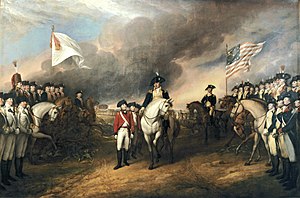Surrender of Lord Cornwallis
| Surrender of Lord Cornwallis | |
|---|---|
 | |
| Artist | John Trumbull |
| Year | 1819–1820 |
| Type | Oil painting |
| Dimensions | 3.7 m × 5.5 m (12 ft × 18 ft) |
| Location | United States Capitol rotunda, Washington, D.C., U.S. |
| Owner | United States |
The Surrender of Lord Cornwallis is an oil painting by John Trumbull. The painting, which was completed in 1820, now hangs in the rotunda of the United States Capitol in Washington, D.C.
The painting depicts the surrender of British Lieutenant General Charles, Earl Cornwallis at Yorktown, Virginia, on October 19, 1781, ending the Siege of Yorktown, which virtually guaranteed American independence. Included in the depiction are many leaders of the American troops that took part in the Siege of Yorktown.
In October 1781, the successful siege of Yorktown, Virginia, by
Commission
Artist John Trumbull (1756–1843) spent the early part of the American Revolutionary War as a soldier, serving as an aide to both George Washington and Horatio Gates.[1] After resigning from the army in 1777, he pursued a career as an artist. In 1785 he began sketching out ideas for a series of large-scale paintings to commemorate the major events of the American Revolution.[2] After spending a time in England, he returned to New York City in 1789, where he sketched a number of dignitaries whose portraits he intended to use in these paintings.[3] In 1791 he traveled to Yorktown, Virginia, where he sketched the landscape of the surrender site.[2]

Upon his return from Britain after the end of the War of 1812, he promoted this idea to the United States Congress. On the strength of his application and the successful exhibition of The Death of General Warren at the Battle of Bunker's Hill, June 17, 1775 and The Death of General Montgomery in the Attack on Quebec, December 31, 1775, as well as studies for other proposed paintings, the Congress in 1817 voted to commission four large paintings from him, to be hung in the United States Capitol rotunda.[2][4]
The price was set at $8,000 per painting, with the size and subject matter to be determined by President
Trumbull himself cleaned and varnished the painting in 1828, and it has been periodically maintained since. In 1971, damage from a penny that was thrown hard enough to pierce the canvas was repaired.[2] All of the Rotunda paintings were most recently cleaned in 2008.[2]
Description


The subject of this painting is the surrender of the British army at Yorktown, Virginia, in 1781, which ended the last major campaign of the Revolutionary War. The blue sky filled with dark clouds and the broken cannon suggest the battles that led to this event. In early September, entrenched with a force of 7,000 men, Cornwallis had hoped for rescue from the sea, but the British vessels were repelled by a French fleet. Within weeks General Washington had deployed a much larger army, and his artillery bombarded the British positions in early October. After American and French troops overran two British strongholds, Cornwallis surrendered on October 19, 1781.[2]
In the center of the scene, American General
See also
Notes
References
- Architect of the Capitol. "Surrender of Lord Cornwallis". Retrieved 2011-05-12.
- Weir, John Ferguson (1901). John Trumbull: a brief sketch of his life. C. Scribner's. p. 36.
Burgoyne.
 This article incorporates public domain material from Surrender of Lord Cornwallis. Architect of the Capitol.
This article incorporates public domain material from Surrender of Lord Cornwallis. Architect of the Capitol.
External links
- Architect of the Capitol Web page on the painting

